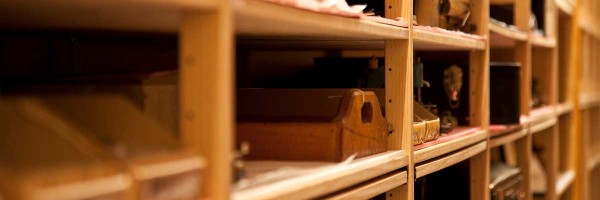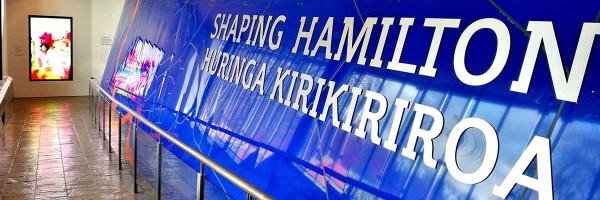Education programmes
Waikato Museum's wide-ranging Education Programmes include hands-on classroom-based sessions, exhibition tours and gallery activities. Our programmes are informed by the New Zealand Curriculum – ensuring we align with your school learning goals – and by our current exhibitions and events. Most of our programmes are developed for tauira from primary to secondary.
For older secondary, tertiary or adult interest groups, please contact us to explore what we can offer your learners. We provide Education Programmes around all our exhibitions, and welcome older learners who would like to engage with these exhibitions.
Education programmes at Waikato Museum
Primary
- Ka tuu te ihiihi, ka tuu te wehiwehi Art that speaks, art that awes
- Te taiwhanga ringatoi The artist’s studio
- Huringa Kirikiriroa Shaping Hamilton
- He waipuna, he waihanga Te awa o Waikato: our wellspring of creation
- Whakatoomene i te ara hihiko It’s electrifying: Exploring electrical circuits
Secondary
- Kia aweawe te ao katoa The power of the transcustomary
- He toi maama te titiro Free your art: Art to calm, art to express, art to replenish the earth
- Mai i te poo ki te ao Museum collections: Journeying between darkness & light
- Huringa Kirikiriroa Shaping Hamilton
- He waipuna, he waihanga Te awa o Waikato: our wellspring of creation
ECE / Early Primary
Sample timetables
If you have fewer than 30 tauira, you will not need to do rotations. Your whole group can stay together for the duration of your visit.
Sample timetable for 30-60 tauira (two-way rotation)

Sample timetable for 60-90 tauira (three-way rotation)

Primary - Education programmes at Waikato Museum
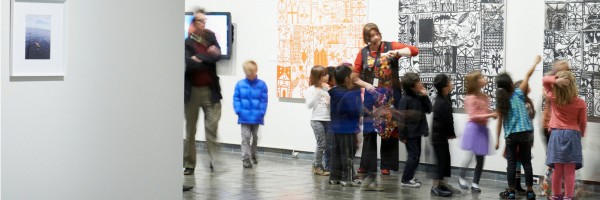
Ka tuu te ihiihi, ka tuu te wehiwehi Art that speaks, art that awes
Looking at artworks and toi Maaori from our current exhibitions, we break down the barriers to enjoying art via sense-based, no-judgment exploration & contextual discussion. Gallery based.
Curriculum Links
- Visual Arts | Ngā Toi
Suggest Learning Outcomes:
- Learn some sensory observation techniques for art viewing
- Practise articulating what you see and drawing likenesses
- Learn to contextualise, looking for artists, dates, cultural information, art movements and narratives
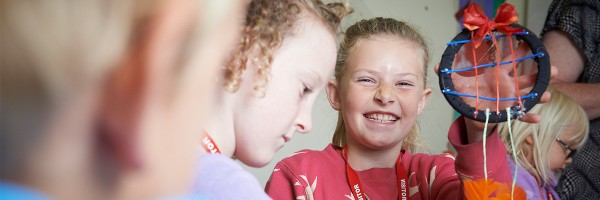
Te taiwhanga ringatoi The artist’s studio
Students will respond to our exhibitions, and explore the significance and value of our arts and toi Maaori, by creating their own unique artwork. Classroom based.
Curriculum Links
- Visual Arts | Ngā Toi
Suggested Learning Outcomes
-
Respond to artworks and exhibition themes, develop skills in interpreting and conveying meaning using the language of art
-
Investigate art making, artists and the discipline of art
-
Draw on a variety of sources of motivation to develop ideas and make art
-
Explore and use the elements, conventions, processes, techniques, and technologies of visual art
[Complements Ka tuu te ihiihi, ka tuu te wehiwehi / Art that speaks, art that awes for a double Education experience]
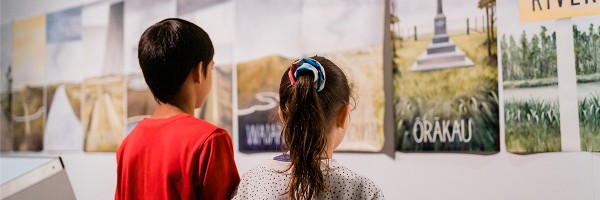
Huringa Kirikiriroa Shaping Hamilton
This programme supports the new Aotearoa NZ Histories curriculum by telling the narratives of our region. Students will explore our objects and taonga, hear some of the puuraakau of our local area, and understand changes over time.
Audience
- Years 3 to 8
Curriculum Links
- Social Sciences |Tikanga-ā-iwi
- Aotearoa New Zealand’s Histories
Suggested Learning Outcomes
-
Understand that Maaori are tangata whenua, explore narratives of the Tainui waka’s migration, arrival and influence on this region
-
Explore the local area, including puuraakau, important Maaori sites, historical places, buildings and streets, and the significance of naming
-
Examine how Kirikiriroa has changed over time through successive settlements, exploring narratives through objects and taonga
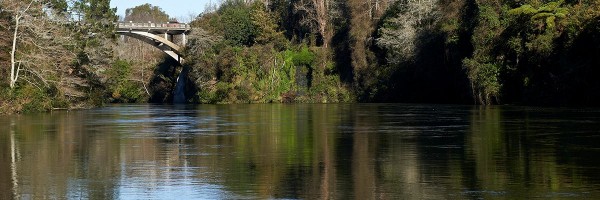
He waipuna, he waihanga Te awa o Waikato: our wellspring of creation
Focusing on the Kirikiriroa whenua of Te Whare Taonga o Waikato (Waikato Museum), we consider past, current and future meanings and uses of our awa. We also touch on the significance of the gullies and repo restoration.
Curriculum Links
- Science | Pūtaiao
- Social Sciences | Tikanga-ā-iwi
Suggested Learning Outcomes
-
Understand our awa’s geographical origins via puuraakau
-
Learn about Maaori settlements and paa sites
-
Explore changes to the awa during the Waikato Wars and colonisation
-
Understand historic and cultural uses of the awa and their impact
Option A
The awa as an energy source. Exploring hydropower, wind, coal and geothermal energy
[Complements Whakatoomene i te ara hihiko / It’s electrifying: Exploring electrical circuits (Years 3-8)]
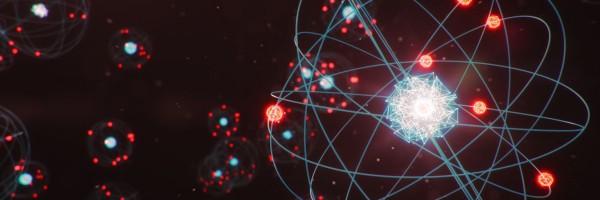
Whakatoomene i te ara hihiko It’s electrifying: Exploring electrical circuits
Hands-on programme exploring parts of an atom and looking at how electrons generate energy, discover the difference between current and static electricity, how atoms travel, what insulators and conductors are, and how circuits work
Audience
- Years 3 to 8
Curriculum Links
- Science | Pūtaiao
Suggested Learning Outcomes
-
Understand what electricity is and the distinguish between current and static electricity - explaining how atoms move
-
Use terminology such as electrons, electrical charge, electrical potential, resistance, current, power, conductor, insulator etc.
-
Identify the elements of an electrical circuit and materials that conduct or insulate electricity
Secondary - Education programmes at Waikato Museum
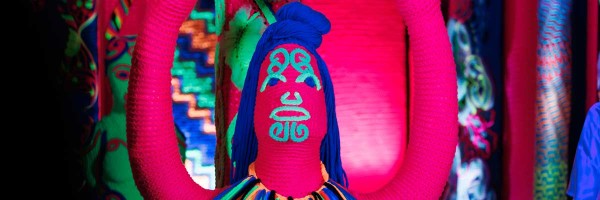
Kia aweawe te ao katoa The power of the transcustomary
Using artworks and toi Maaori from our current exhibitions, we explore the wonders and dangers of cultural exchange in artmaking.
Curriculum Links
- Visual Arts | Ngā Toi
Suggested Learning Outcomes
-
Introduce some customary Maaori art practices
-
Look at some Maaori borrowings from colonial art forms
-
Introduce art as a colonial tool (imperial gaze, primitivism, surrealism, appropriation)
-
Explore contemporary Maaori art as transcustomary practice
Image: Detail of Wharenui Harikoa by Lissy and Rudi Robinson-Cole

He toi maama te titiro Free your art: Art to calm, art to express, art to replenish the earth!
We explore using recycling and DIY techniques to get a message or a feeling out. From collage to found poems to linocut to zine-making, we follow creatives in history who have expressed themselves without high-tech or expensive materials. Use what’s around you, reduce your impact on Papatuuaanuku, let it flow!
Curriculum Links
- Visual Arts | Ngā Toi
Suggested Learning Outcomes
-
Introduce some countercultural art making and protest practices
-
Learn to use art techniques and materials to interpret, process and respond to current events, personal experiences and more
-
Equip students with skills and confidence in provisional, on-the-fly, experimental and freeform creative strategies
[This programme is designed to adapt to current exhibitions and work alongside other Education programmes. Skills learned will change accordingly. Can also stand alone as an offering for community and adult groups.]
Mai i te poo ki te ao Museum collections: Journeying between darkness & light
Using objects and taonga Maaori from our collections, we explore the ever-evolving role of Museums in contemporary life.
Curriculum Links
- Social Sciences |Tikanga-ā-iwi
Suggested Learning Outcomes
-
Introduce how Museum collections have come about, and how Museums see their roles, practices and collections today
-
Understand how objects, taonga, etc are valued differently by different cultures
-
Introduce some practices for looking at taonga/objects, thinking about and researching them
-
Learn some current Museum processes for caretaking objects and taonga, and moving them between spaces
-
Introduce concepts of repatriation and decolonising methodologies
Huringa Kirikiriroa Shaping Hamilton
This programme supports the new Aotearoa NZ Histories curriculum by telling the narratives of our region. Students will explore our objects and taonga, hear some of the puuraakau of our local area, and understand changes over time.
Curriculum Links
- Social Sciences |Tikanga-ā-iwi
- Aotearoa New Zealand’s Histories
Suggested Learning Outcomes
-
Understand that Maaori are tangata whenua, explore narratives of the Tainui waka’s migration, arrival and influence on this region
-
Explore the local area, including puuraakau, important Maaori sites, historical places, buildings and streets, and the significance of naming
-
Examine how Kirikiriroa has changed over time through successive settlements, exploring narratives through objects and taonga
-
Explore and discuss the He Whakaputanga, Te Tiriti o Waitangi and the development of the Kiingitanga, introducing concepts of tino rangatiratanga, sovereignty, governance, colonisation, invasion, confiscation and raupatu
He waipuna, he waihanga Te awa o Waikato: our wellspring of creation
Focusing on the Kirikiriroa whenua of Te Whare Taonga o Waikato (Waikato Museum), we consider past, current and future meanings and uses of our awa. We also touch on the significance of the gullies and repo restoration.
Curriculum Links
- Science | Pūtaiao
- Social Sciences | Tikanga-ā-iwi
Suggested Learning Outcomes
-
Understand our awa’s geographical origins via puuraakau
-
Learn about Maaori settlements and paa sites
-
Explore changes to the awa during the Waikato Wars and colonisation
-
Understand historic and cultural uses of the awa and their impacts
Option
River & gully ecologies. Explore gully/repo ecologies & restoration, including bats, pukatea, tootara, kahikatea, tawake. [Seasonal]
ECE - Education programmes at Waikato Museum
Puuraakau Amazing stories
Using cultural narratives and contemporary stories, this programme invites tamariki to feel at home in the museum. Through interactive koorero, puuraakau and waiata in our galleries, tamariki can make personal links to objects/ taonga and exhibitions.
Suggested Learning Outcomes
-
Making connections between people, places, and things in their world
-
Knowledge about features of the local area, such as a river or mountain (this may include their spiritual significance)
-
Experience the stories and symbols of their own and other cultures and Te Marautanga o Aotearoa, making meaning of the ideas they receive
-
Know they know that they have a place and can take part in caring for this place


